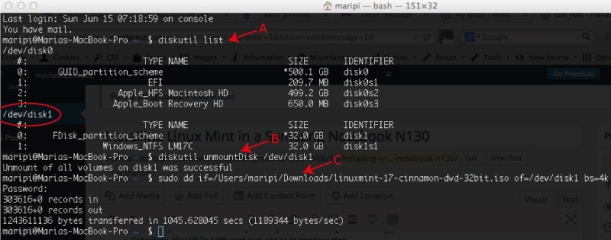Very recently I attended a Restarters London meetup for women interested in giving a new life to old computers by installing a Linux distro on them. I took with me an old Samsung Notebook N130 which was running Windows XP. The introduction to Linux by Paula @Fossbox was very informative and allowed me to decide that Linux Mint was the appropriate distro for the computer. Unfortunately, I couldn’t install Linux as the computer wouldn’t boot from the USB flash drive.
So at the end of the meeting Janet, who organises these meetups, challenged me to install it first; she had the same computer. This blog post is the result of the challenge, I hope you find it useful.
1- Download the Linux distro
Search for downloads of the Linux distro you want. I found a website dedicated to Linux Mint and used the UK mirror to download the latest 32-bit version which is called “Quiana” and has the ‘Cinnamon’ desktop; all sounded very interesting! Depending on your connection this might take a while; it took around 10 minutes for me. This is the name of the file that was saved on my downloads folder, notice the .iso extension at the end of the name:
linuxmint-17-cinnamon-dvd-32bit.iso
2- Create a bootable USB flash drive
I used my Mac to create a bootable USB flash drive. I believe you need a flash drive that is at least 4GB. Following the instructions, this is how it worked for me.

Step A – Plug-in your flash drive in the mac and open the Terminal so you can enter the following commands (Applications > Utilities > Terminal.app).
$ diskutil list
My flash drive can be found on /dev/disk1.
Step B – Unmount the disk. See step B on image.
Note: substitute /dev/disk1 for the one you found on your computer on the previous step.
$ diskutil unmountDisk /dev/disk1
Step C – Write the content of the iso file to your flash drive. See step C on image.
Notes:
- This is a one line of code and there is one space after the name of your iso download
- After ‘if=’ you need to enter the path to your iso download as per your own computer
- Substitute /dev/disk1 with your own one as in previous step
- Enter the password for your computer after running the command when prompted
$ sudo dd if=/Users/maripi/Downloads/linuxmint-17-cinnamon-dvd-32bit.iso
of=/dev/disk1 bs=4k
Be patient now. The first time I tried something went wrong; after half an hour the process hadn’t completed so I decided to stop it by using Ctrl+c on the terminal. I then reformatted the flash drive. The second time it took around 20 minutes to complete.
Unplug your flash drive.
3- Install Linux Mint into the Samsung N130
Plug the flash drive in the Samsung notebook. Restart your computer and press the Esc key as it is restarting (thanks Richard from Just Outsource IT for this tip); this will bring up a window where you can select to boot the computer from the flash drive.
Finally on your desktop double click on the icon ‘Install Linux Mint’ and follow the prompts.
Notes:
- when prompted connect to the internet if possible, so that Linux Mint can install additional drivers
- make sure you write down your login and password details – I didn’t write mine down and had to repeat step 3 again!
- Reformat the flash drive to be able to use it for something else



